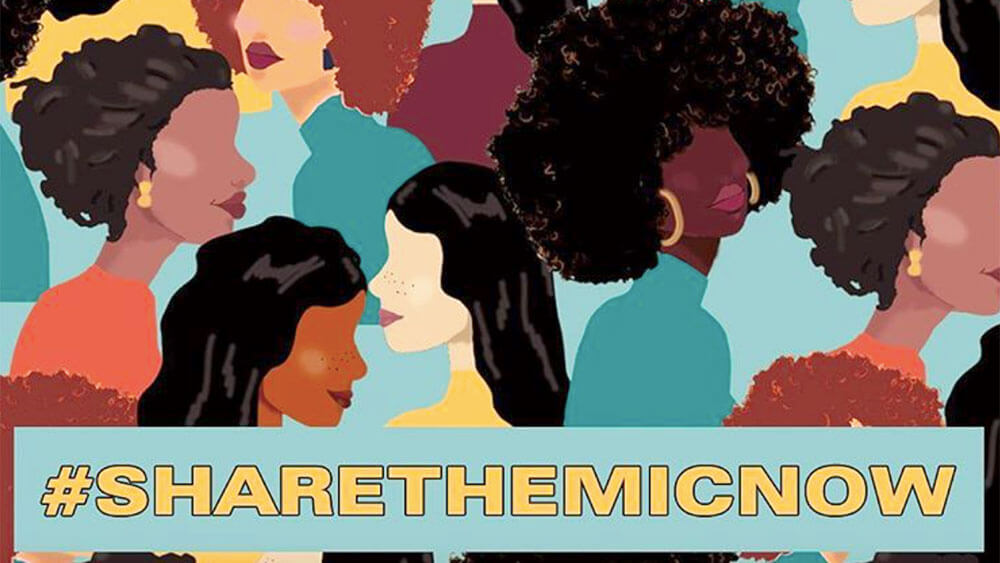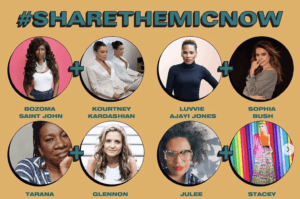
#SharetheMIcNow is a social media campaign that invited 46 Black women to take over the Instagram accounts of 46 white women who have a combined audience of 300 million followers. (Courtesy #Sharethemicnow)
In a story published last September in the Harvard Business Review, Ruchika Tulshyan, author of The Diversity Advantage, asked: What will it take to improve diversity at conferences? It is a question that has only become more urgent as the world reckons with the effects of systemic racism on our institutions and culture.
There has been lots of talk about why all-male panels are a problem, Tulshyan, the founder and CEO of Candour, a diversity consulting company, wrote last fall. “But less attention has been paid to how too many events also lack racial diversity.” In addition to recognizing the structural barriers that have kept people of color from appearing on conference agendas, there are practical steps that conference organizers can take to change the tide, she wrote. “We need to fundamentally understand and accept how different perspectives and life experiences among speakers will bring a richer conversation to any conference.”
They include:
- Don’t only look for experts by title. When conference organizers’ default choice is the so-called “best” in a category, it usually defaults to white men, reflecting society’s power dynamics. Look for speakers outside traditional networks and for differences in experience and points of view, not fancy titles, she advises.
- Set audacious goals. Quantify the diversity benchmarks you’re hoping to achieve at your conference and make them ambitious ones. Whatever you do, don’t just add one “token” speaker from an underrepresented background to your conference agenda, she writes. Research shows that instead of adding to the diversity of viewpoints, a single representative will feel compelled to assimilate to the surroundings.
- Ask for speaker recommendations from a diverse slate of people. Make it a rule of thumb to ask for recommendations from a diverse group and be explicit about the fact that you are cultivating speaker diversity and value non-traditional speakers.
- Pay speakers. Some of the biggest inequities are created when speakers are expected to speak for free to gain exposure — speaking for free isn’t a realistic option for many people, particularly those who are most disadvantaged by the racial wealth gap. At the minimum, compensate for travel and lodging, and “especially,” she writes, ensure that it doesn’t happen that some speakers get compensated while others don’t.
- Don’t always enlist people of color to speak about diversity issues. People who are qualified to talk on a range of topics often get asked to speak on the “diversity” panel or address “what it’s like to be a woman/person of color/disabled person/LGBTQ person in [insert field here] because of their presenting identity,” Tulshyan noted. The ideal professional conference is one where speaker diversity is curated into all topic tracks and doesn’t need a diversity and inclusion track.
- Pass the Mic. If you frequently get asked to speak and you identify as white and male, recommend that a speaker from an underrepresented community take your place, Tulshyan suggests.

#SharetheMIcNow paired, among others, celebrity Kourtney Kardashian and marketing executive Bozoma Saint John.
Eight months after Tulshyan made that suggestion — handing the spotlight over to someone less visible — the June 10 #ShareTheMicNow campaign was launched, in which 46 Black women were invited to take over the Instagram accounts of 46 white women who have a combined audience of 300 million followers. Pair-ups includes celebrity Kourtney Kardashian and marketing executive Bozoma Saint John; sociologist and author Brené Brown and speaker and author Austin Channing Brown; Sen. Elizabeth Warren and Alexis McGill Johnson, the acting president of Planned Parenthood.
- Use your sponsorship privilege. Sponsors can vote with their dollars and “specifically state that you’re looking to use your sponsorship budget to create a diverse and inclusive environment,” she writes.
- Refuse to speak at or attend an event with a homogenous lineup. The more high-profile you are, the more impact you’re likely to make when you take this action, but everyone can vote with their dollars. Attend conferences that do prioritize speaker diversity, and specifically state why you value this. “I find it a waste of time,” Tulshyan writes, “to attend a conference where I won’t learn from a wide variety of expertise, views, and experiences.”
